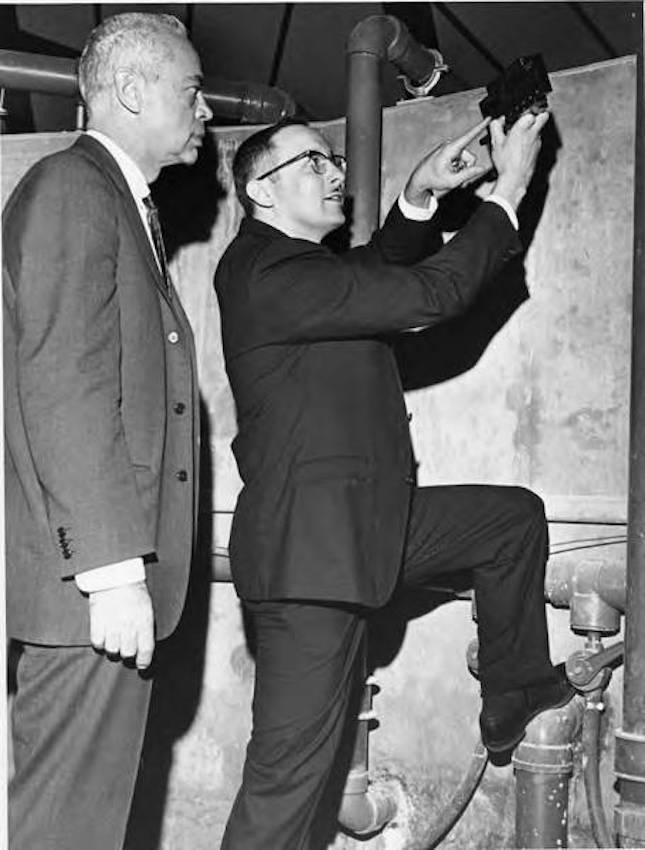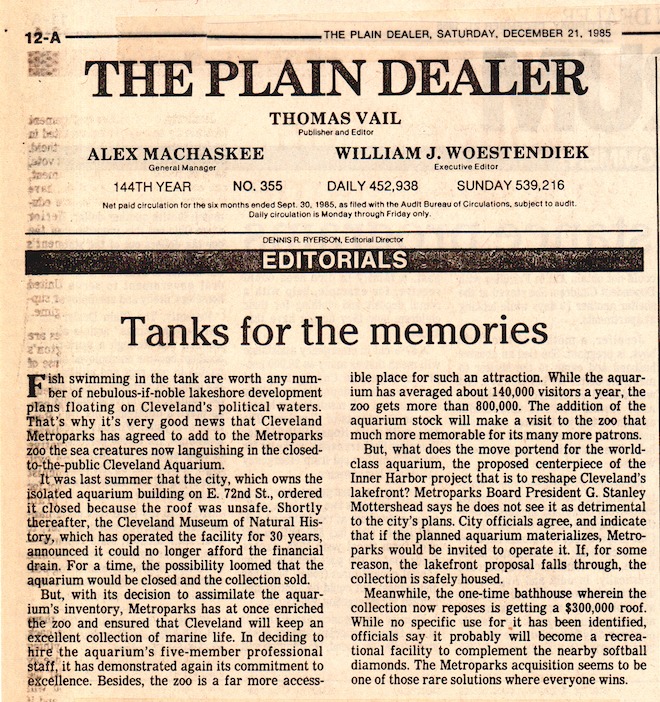
Cleveland's first aquarium, located in Gordon Park, was the product of a unique collaboration of public agencies and citizen volunteers. With support from the City and the Cleveland Museum of Natural History, volunteers fashioned the aquarium from a former bathhouse-turned-museum. Although it operated for barely a generation, the old Cleveland Aquarium played a role in elevating the stature of aquariums as serious marine research centers.
The Cleveland Plain Dealer announced the grand re-opening of the Cleveland Aquarium in its September 5, 1954 edition, citing it as the “most public institution of its kind.” The unique aspect of the Aquarium’s development in Gordon Park was the “brick by brick... fish by fish... drop by drop” building of the facility by the Cleveland Aquarium Society, Cleveland Museum of Natural History (CMNH), as well as volunteer "sportsmen, amateur marine biologists, teachers, housewives, and youngsters." The effort began in 1954 when the building, utilized as a Trailside Museum, was threatened with closure. Aquarium Society members contributed material, labor, and fundraising efforts to retrofit the trailside facility to house a public aquarium.
Gordon Park had evolved from a bathing beach attraction on Cleveland’s east side along Lakeshore Boulevard during the 1940s and 1950s. The construction of an improved Memorial Shoreway (later part of Interstate 90) split the park into a lakefront boat access area and an inland park area with sports fields and picnic areas. The limited beach access and usage led the former bathhouse on the inland grounds to be converted to a Trailside Museum by CMNH in 1943. It housed natural history specimens of the area, including several small aquariums containing fish from Doan Brook and Lake Erie. The opportunity to create a large, dedicated, public aquarium became a reality with the cooperative efforts of the city, CMNH, and the volunteers who planned and built the facility to house local aquatic specimens as well as tropical species in a controlled habitat. Director William Kelley characterized the Cleveland Aquarium as an applied research center—as opposed to a “fish circus”—and hoped to continue the research theme to influence other aquaria around the world.
By the time the grand opening occurred, existing display tanks were renovated and ten 500-gallon tanks were installed to welcome aquatic life to Cleveland’s lakefront. The early years of the aquarium saw the expansion of the aquatic life collection via ‘expeditions’ to the Florida Keys. Staff and volunteers organized trips and contributors to harvest specimens and safely ship them back to Cleveland to include in the collection. During one 1955 "safari," aquarium staff returned with a baby shark, a moray eel, a sea turtle, a porcupine fish, and a spiny box fish among others. The staff was challenged to ship the specimens in their habitat and to acquire 600 gallons of ocean water for their new home. This challenge was met by the Aquarium staff who later improved upon a German colleague's formulated substitute seawater and dubbed it Instant Ocean. In 1964, Director Kelley left the Aquarium and patented the successful compound and founded Aquarium Systems, Inc. to market Instant Ocean and continue refinements here and in Europe for international distribution.
Throughout these developmental years, the Aquarium distinguished itself as a research facility beyond the role of museum collections and display of aquatic life. The growth and success of the Aquarium program was well received by the public and private funders alike. Museum visitors grew annually and foundation and corporate contributors supported the efforts. By the mid 1960s, these successes called for the expansion or development of a larger aquarium in Cleveland. After several proposals to relocate the facility, an expansion of the existing facility was agreed upon and a $300,000 grant from the Leonard C. Hanna Jr. Fund supported the tripling of the existing site. The continued growth of the Aquarium included cooperative efforts with universities and other aquarium programs. These initiatives enhanced its stature in the world of aquatic science. The species collection represented worldwide contributions of varieties of freshwater and ocean specimens.
The operation of the Aquarium was influenced by the nature of its creation. The contributions of volunteers and the cooperation of the CMNH to operate the Aquarium prompted the City of Cleveland to support the effort—Cleveland owned Gordon Park where the Aquarium stood. Annual reports indicated operating costs of $20,000-$30,000 with the city underwriting $17,000 and admissions, CMNH support, and occasional foundation contributions to cover costs. The revenue routinely fell short of expenses despite the increased annual attendance and popularity of the attraction. The multi-faceted budget became a political process. By 1961, CMNH began to study the option to separate the operation of the Aquarium and discussions began about its expansion. Throughout the 1970s operations persisted and the city maintained its annual $17,000 subsidy despite mounting annual deficits reaching $140,000 culminating in a showdown with Cleveland Mayor Dennis Kucinich in 1979. Increased external funding support and city council’s override of the mayor’s veto of increased admission fees kept the aquarium open for the foreseeable future. As the 1970s drew to a close, ’Moses,' the biggest and oldest resident grouper, died, perhaps signaling the aquarium's fate.
The early 1980s brought additional debate with the city which would decide the Aquarium’s future. Plans brought by private developers to relocate the Aquarium with other maritime museums in the Nicholson building (East 55th at Lake Erie shore) conflicted with the city’s proposal to develop the lakefront at East 9th Street to include a new aquarium. The administration of Mayor George Voinovich prevailed to support the downtown plan which never materialized as announced—instead the Rock and Roll Hall of Fame and the Great Lakes Science Center occupy the space. By 1985, structural problems due to saltwater corrosion emerged at the Gordon Park facility. Collapsed ceiling panels forced its closure in June 1985 and further negotiations removed the Cleveland Aquarium’s contents and program from CMNH oversight at Gordon Park to the Cleveland Metroparks Zoo in 1986 with continued hope of a new facility at the Inner Harbor. Discussions among aquarium supporters remained active through 2009, when developer Jeff Jacobs announced a project partnering with external developers and consultants to locate a new aquarium in the downtown Flats.
Images










